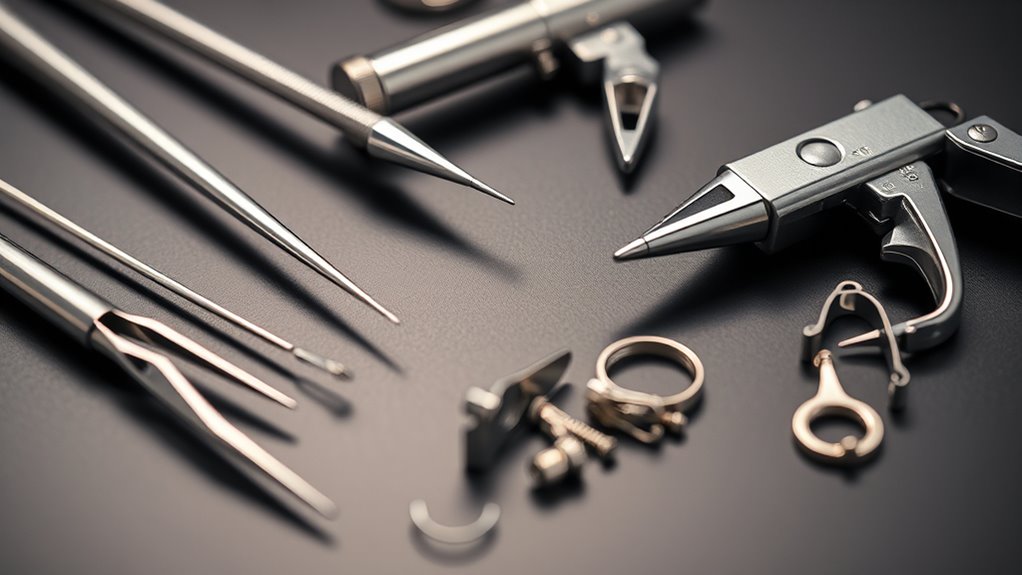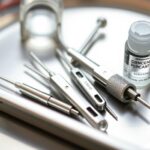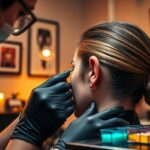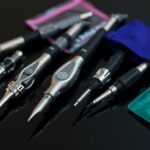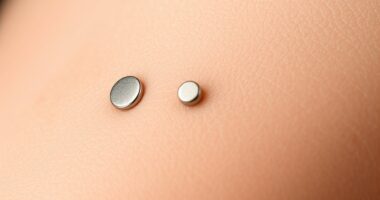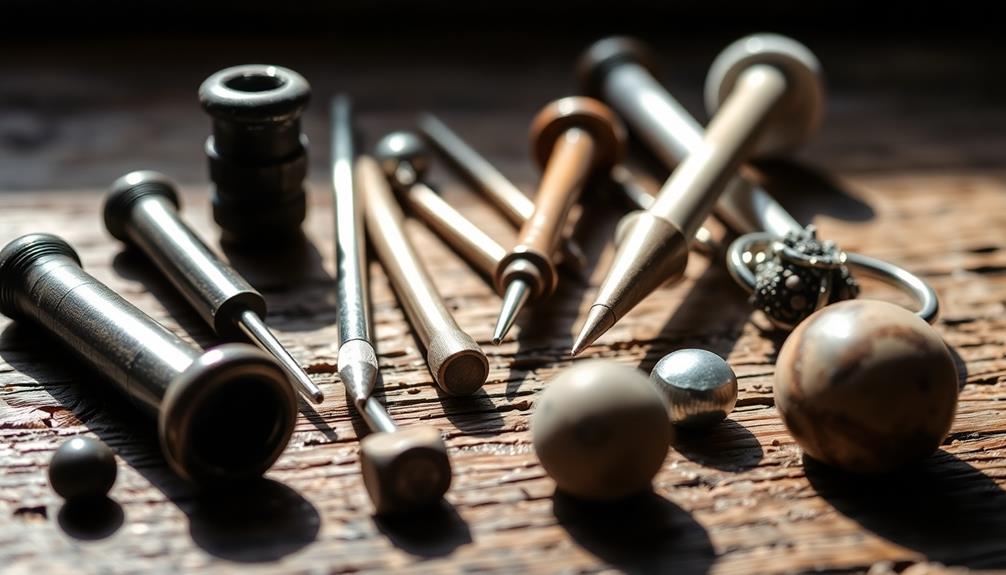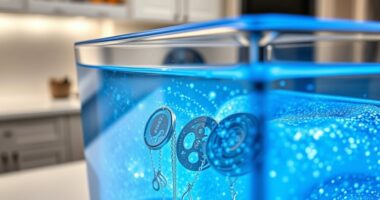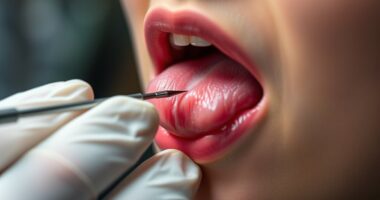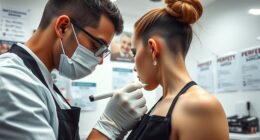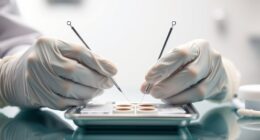To perform safe septum and daith piercings, you need professional-grade tools like sterile hollow needles, high-quality forceps, and specialized jewelry insertion pliers. Using autoclaved instruments and maintaining a sterile environment reduces infection risks and guarantees precise placement. Choosing surgical-grade materials such as titanium or surgical steel for jewelry also matters. With the right tools and techniques, you’ll promote healthy healing and satisfaction. Keep exploring to discover more about the essential equipment for these piercings.
Key Takeaways
- Use sterile, hollow needles designed specifically for cartilage piercings like septum and daith.
- Employ high-quality forceps and specialized insertion pliers for precise placement and jewelry handling.
- Sterilize all tools, including needles and forceps, with autoclaves to prevent infection risks.
- Select hypoallergenic jewelry made from surgical steel, titanium, or niobium to ensure safety and compatibility.
- Maintain a sterile environment with proper sterilization protocols and air filtration to ensure safe piercing procedures.

Getting septum and daith piercings requires the right tools to guarantee safety and precision. When you’re considering these piercings, having professional-grade equipment is essential to minimize risks and ensure a smooth healing process. Using proper tools not only makes the piercing more accurate but also reduces the likelihood of complications like infections or improper placement. The right instruments help maintain a sterile environment, which is vital for successful healing and long-term satisfaction with your piercing.
Using professional tools ensures safe, precise piercings and promotes successful healing.
For initial piercings, sterile needles are the cornerstone. Unlike piercing guns, which can cause trauma and aren’t suitable for cartilage piercings like septum and daith, professional piercers prefer hollow, sterilized needles. These needles allow for cleaner, more controlled punctures, reducing tissue damage and promoting a better healing process. Alongside needles, high-quality forceps are used to handle jewelry and keep the area steady during the piercing. These forceps are designed to be easy to sterilize and grip securely, giving you precision throughout the procedure.
Once the piercing is complete, the focus shifts to aftercare routines. Proper aftercare involves specific tools, like saline solution sprays or sterile gauze, to clean the piercing effectively. Using a gentle, sterile cleaning solution ensures bacteria don’t settle in the new piercing, helping to prevent infections and support healthy tissue regeneration. Many professionals also recommend small, angled brushes for gentle cleaning around the jewelry, especially in tricky areas like the septum or daith.
Jewelry selection tools are another critical aspect of professional equipment. High-quality, implant-grade materials like surgical steel, titanium, or niobium are preferred because they’re less likely to cause allergic reactions or irritation. Professionals use specialized pliers to insert or change jewelry, ensuring a secure fit without damaging the fresh piercing. These tools allow you to maintain the integrity of the piercing during healing and reduce discomfort during jewelry swaps later on.
In addition, a professional piercer’s toolkit includes sterilization equipment like autoclaves to keep all tools free of contaminants. This ensures that every needle, forceps, or jewelry-changing tool used during your piercing is completely sterile, which is fundamental for a healthy healing process. By trusting professional tools and techniques, you’re setting yourself up for a smoother healing journey and better long-term results. Proper tools help you follow effective aftercare routines that promote healing and preserve the beauty of your septum or daith piercing for years to come. Incorporating HEPA filters in the studio environment can further reduce airborne contaminants, ensuring the highest standards of sterility during procedures.
Frequently Asked Questions
How Do I Sterilize My Piercing Tools at Home?
To sterilize your piercing tools at home, start with thorough cleaning using soap and hot water to remove debris. Then, use sterilization methods like boiling tools in water for at least 20 minutes or soaking them in 70% isopropyl alcohol for 10-15 minutes. Always let tools air dry on a clean surface, ensuring safe at-home cleaning to prevent infections and keep your piercing safe.
What Are the Best Materials for Septum and Daith Jewelry?
Choosing the best materials for septum and daith jewelry means you prioritize both beauty and durability. Titanium tops the list with its tough, hypoallergenic traits, making it perfect for sensitive skin. Surgical steel is sturdy and safe, while niobium offers flexibility without sacrificing strength. These material options guarantee your jewelry remains resilient, comfortable, and beautiful, giving you confidence in your piercing’s longevity and your skin’s health.
How Often Should I Replace My Piercing Tools?
You should replace your piercing tools regularly to maintain safe, sterile conditions. Proper piercing tool maintenance involves sterilizing them after each use, and sterilization frequency depends on how often you perform piercings—ideally daily or after every procedure. Never reuse unsterilized tools, and always check for signs of wear or damage. This ensures your tools stay effective and reduces the risk of infection, keeping your piercings healthy and safe.
Can I Use Regular Piercing Tools for Other Body Parts?
Did you know that improper tool use can increase infection risks by up to 50%? You shouldn’t use regular piercing tools for other body parts because different piercing techniques require specific tools for safety and precision. Tool compatibility is essential; using the wrong tools may cause tissue damage or improper healing. Always choose specialized equipment designed for each piercing area to guarantee proper technique and minimize complications.
What Safety Precautions Should I Take During Piercing?
You should always prioritize safety during piercing by using proper sterilization techniques to prevent infection. Wear sterile gloves and guarantee all tools are properly sterilized before use. Follow strict piercing aftercare instructions, such as cleaning the piercing with saline solution and avoiding touching it with dirty hands. Avoid swimming or submerging the piercing in unclean water, and monitor for signs of infection. Proper precautions protect your health and promote quick healing.
Conclusion
With the right tools in hand, you’re armed like a skilled artist ready to craft your perfect piercings. Think of your toolkit as a set of magic wands, transforming pain into beauty and hesitation into confidence. Each instrument is a brushstroke in your personal masterpiece. So, embrace your journey with care and precision—because with the right tools, you’re not just piercing, you’re creating a stunning work of art that’ll shine brighter than the stars.
Piecing together a life one day at a time, that’s me. I’m Rusty, and I love being editor-in-chief of creative piercing. It’s my passion to help others see their vision and bring it to life. When I’m not working or taking care of my family, you can find me reading a good book or eating pie (of course!).

